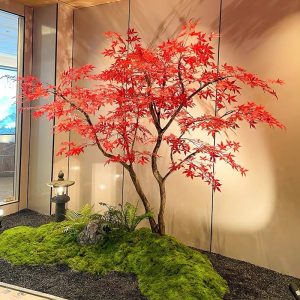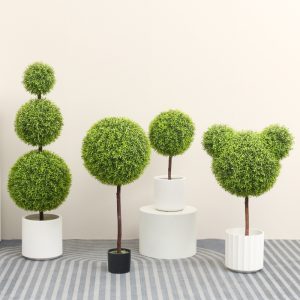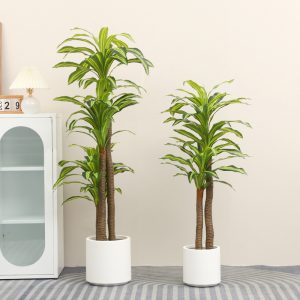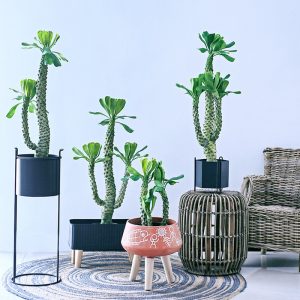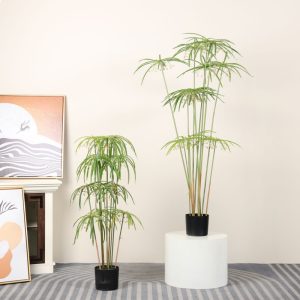9:00 a.m., Friday, May 14, 2025, in the downtown Chicago high-rise office building, the morning light filtered through the blinds, casting long, narrow patches of light on the light gray carpet. As I pushed the coffee cart through the open-plan office, my peripheral vision was suddenly caught by a splash of bright red in the reception area—a cluster of maple leaves peeking through the glass partition, gently swaying in the air conditioning breeze.
“Lily, look at that tree by the front desk!” The new intern, Sarah, ran over with a latte in hand. On the white plant stand next to the front desk stood a 1.6-meter-tall artificial maple tree. The dark brown branches spread out, adorned with palm-shaped leaves layered on top of each other. The topmost leaves were a translucent orange-red, gradually fading into warm golden-yellow as they descended. Sunlight slanted across the leaves, making them glow amber-like, and even the few faux tree veins on the trunk seemed like natural imprints carved by years of wind and rain.
This was the artificial maple tree that had been placed in the office just last week. Over the three years I’d worked here, the front desk had been decorated with plants many times. But this artificial maple tree was different. Right now, standing next to the white front desk, it seemed to wedge a breath of autumn into this space made of glass, metal, and concrete.

“These leaves feel so real!” Sarah reached out and gently touched a leaf near the bottom, feeling the cool suede-like texture. I smiled and handed her a hot cocoa: “I checked it when it was installed last week. The connection between the leaf stems and the branches is made of soft rubber, so you don’t have to worry about them falling off.”
The front desk area was a typical Scandinavian design, and the artificial maple tree in pot stood right between the sofa and reception desk. The best part was its height—it didn’t block the visitors’ view but allowed those waiting to glance up and see the red leaves.
“Yesterday, Linda from finance came over to clock in,” I wiped the coffee pot, “she stared at this tree for five minutes and said the maple leaves back in her hometown in Vermont were the same color right now.” Sarah leaned in closer: “It really does have an autumn vibe!” I knew it was psychological—artificial maple trees don’t emit any fragrance—but the color and shape were so realistic: the veins on the underside of the leaves were slightly lighter than on the top, and the edges were intentionally curled, like they had been touched by an autumn breeze. These details completely changed the atmosphere of the space.
“To be honest,” Mark, the administrative manager, tapped the table at Wednesday’s department meeting, “when we first purchased this artificial maple tree, I was worried people might think it was too ‘fake.’” He pointed to the same style of tree in the corner of the meeting room.
“I used to oppose buying fake plants,” Tom from the tech department raised his hand, “I always thought they lacked the ‘vitality’ of real plants. But last week, when I was working on a project and stayed in the office until midnight for three days, I realized this tree actually looked better at night than during the day—the warm light from the overtime lamps hit the red leaves, and the color became deep, like wine. It was more refreshing than staring at a white wall.”
Mark clicked on the projector and pulled up the purchase records: “Our office faces north, so we don’t get much sun all year. The real pothos we bought last year turned yellow after three months, and fresh-cut flowers are even more of a hassle—they need to be changed every week. This artificial maple tree costs 60% less per month than fresh-cut flowers, and we don’t need to worry about watering or pruning.”
I remembered how, during last week’s rainstorm, the artificial maple tree by the front desk had been drenched by water that leaked in. I simply wiped it down with a dry cloth, and it was as good as new. “And it can ‘change colors,’” Mark clicked on the product description, “next month, before Christmas, we can switch the leaves to dark green; in spring, we can change them to light green, and in summer, to a yellowish hue—this tree can represent all four seasons.”
This made everyone in the meeting room laugh lightly. Emily from marketing shook her mug: “Yesterday, a client came to talk about a potential collaboration. When sitting in the waiting area, they specifically asked about this tree and said, ‘The details of your office are more thoughtfully done than a five-star hotel.’”
“Did you notice,” Sarah followed me into the kitchen at lunch, “since the front desk got that artificial maple tree, everyone’s footsteps slow down when they clock in?” She pointed to the interns, who always stopped for a couple of extra seconds.
The kitchen is the dimmest place in the building. Last week, we moved the last artificial maple tree in pot from the warehouse to a storage rack in the kitchen. Now, every time someone heats their lunch, they look up and see a warm red hue, making those two minutes of waiting seem a little less unbearable.
“Yesterday, I left my lunch in the microwave too long,” Sarah took a bite of her sandwich, “when the microwave alarm went off, I was staring at that red leaf, and I didn’t panic like I used to.” Her words made me think of my own experience: every afternoon at 3:00 p.m., during my “slump time,” I would go stand by the front desk for two minutes, watching the sunlight move across the maple leaves.
The tech department’s dark room is the most “oppressive” place in the company. Yesterday, we moved the artificial maple tree from the meeting room to test it there, and the results were unexpected—Tom sent me a message: “I was stuck on a program for half an hour, but staring at the red leaves suddenly gave me an idea and I solved it.”
“Next week’s client appreciation event,” Mark flipped through the agenda at the Friday afternoon administrative meeting, “we’ll use these artificial maple trees as the main decor.” He pointed to the effect picture on the screen: in the sign-in area, three artificial maple trees will be arranged in an “arch,” and a mini artificial maple tree will be placed in the center of the dining table.
“The procurement department just contacted the supplier,” Mark added, “and said we can change the leaves in our ‘office faux green plants’ package to olive branches and eucalyptus next month.” It suddenly hit me that this artificial maple tree wasn’t just about looking good; it was about “possibility”—you don’t need expensive decor to bring warmth to an office space.
Before leaving for the day, I passed by the front desk and saw the cleaning lady gently wiping the leaves of the artificial maple tree. She moved slowly: “This tree is great—it doesn’t need watering or sunlight, and it still looks this good.” The last rays of sunset filtered through the blinds, landing on the highest red leaf.
When I clocked out, an activity notification popped up on the screen: “‘Red Leaf Photography Contest’—Capture the most beautiful moment of your artificial maple tree in the office.” I smiled at the screen—who would’ve thought that a “fake tree” could completely change the atmosphere of the office?
Perhaps what office workers need is not the hassle of “real plants,” but the “natural feel” that requires no effort to maintain. Just like this artificial maple tree in the office, it won’t wilt because someone forgot to water it, and it won’t shed its leaves because of overtime, but it will quietly offer every tired office worker a piece of warmth that never fades.








